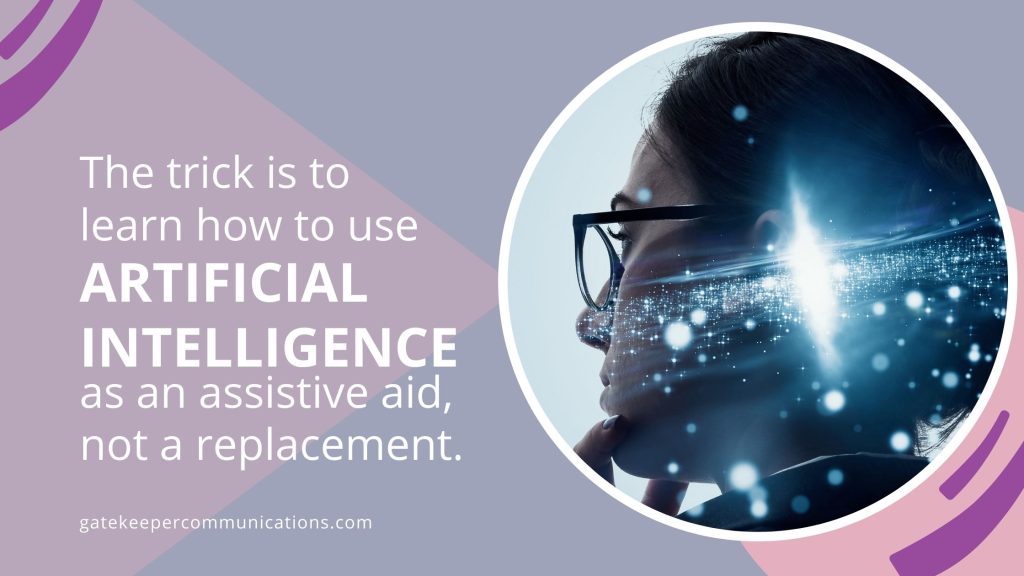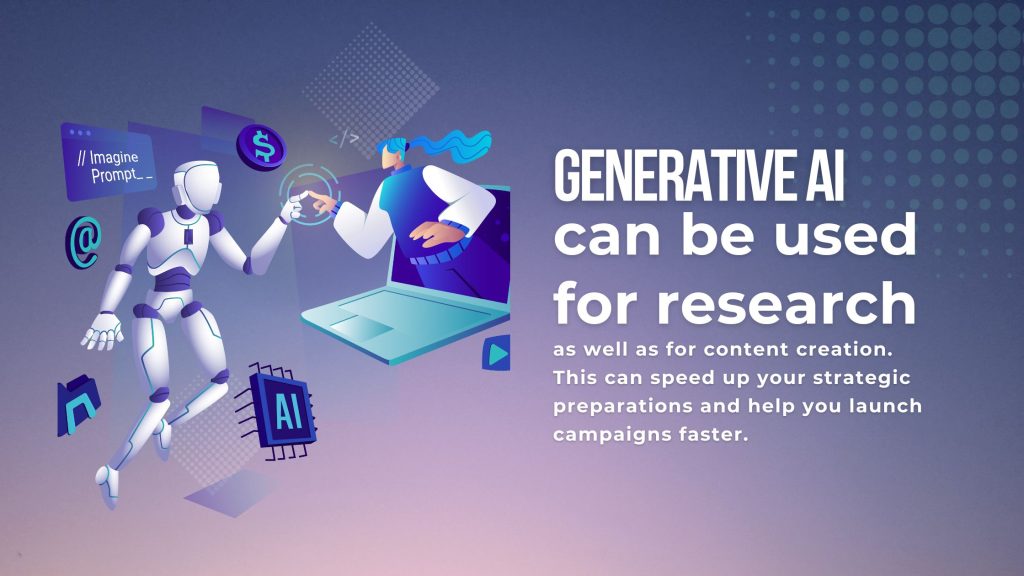Like many other industries, the PR sector has been inundated with new AI tools that can be used to maximise and amplify the results of your PR campaign. Some of those tools will carefully enhance your PR activities, giving you greater value for money and a better return on your investment.
Other tools may be there to help you write a press release, prepare a presentation, or create a series of brand assets.
As a PR Agency in Suffolk, clients often ask me what I think about the growing use of AI in public relations or whether AI writing tools live up to the hype.
I believe that AI writing tools such as ChatGBT or Gemini (formerly known as Bard) aren’t going to go away. But the trick is to learn when and how to use them properly, primarily as a tool to help and support rather than replace.

So, where does it start?
Well, like any affordable PR campaign, your first use of AI integration should focus on your audience’s needs.
While your PR campaign should focus on your overarching goals and KPIs, those goals need to be aligned with what your audience wants. This is where using AI in public relations can be hugely beneficial.
Right now, we’ve got greater access to customer insights than ever before. We know who our customers are, how they behave, and what they think about you. With real-time data analytics at our fingertips, we can really get to grips with who our audiences are and what they care about. This allows you to create strategic PR activities that align directly with your customer base.
Generative artificial intelligence is incredibly insightful.
If you need help getting started with AI in PR, it’s worth knowing that generative artificial intelligence tools can be used for research purposes as well as content creation.

You can easily research examples of poor PR practices.
Did you know that you can use AI tools like ChatGBT to filter out bad ideas or unpopular campaigns? Prompts such as “example of poor PR campaign in the xxx sector” will give you immediate suggestions of bad practice. This is important to know because it’s just as important to learn from examples of poor practice as well as examples of outstanding PR campaigns.
AI will let you know if you’re using complicated language.
Great PR campaigns are about reaching out to new audiences – many of whom may not have been aware of you or your brand. One way that artificial intelligence can be used in PR is to spot the language that you’re using in your press releases or campaign materials.
Obviously, Grammarly and Quill Bot will check your spelling, but did you know they can also simplify your language or help you create new ways of explaining something? By deciding the knowledge base of your audience, you can tailor your content specifically to their needs. For campaigns that have multiple media targets, this is hugely influential; you can make the most of jargon for your B2B trade publications while adjusting your tone of voice for regional or B2C media targets.
AI can help with content generation.
As an Ipswich copywriter as well as a PR specialist, I have mixed feelings about using AI for content generation. Too many people believe that AI writing tools are a replacement for humans, but really, they should be used sparingly.
I like to use AI tools to help with headline generation or subject headings. Having a unique perspective is always good to get my brain working. However, using AI to write content still relies on a human touch. It needs the proper prompts and an overarching narrative behind what you’re trying to say. AI writing tools for copywriting may write a first draft – but if they use statistics or quotations, they may not be the latest iteration.
This is where I have concerns about the use of generative AI in public relations and copywriting. Too many people, perhaps because they have a limited budget or a limited understanding of the role, feel that AI can be used as a straightforward replacement. But the output isn’t yet good enough. That may change in the future; who knows?
But realistically, when public relations is all about managing your reputation, who is better to do that than you?
Conversational intelligence tools can be used to find the intent behind any customer contact.
The growing use of conversational intelligence tools means that brands can now make the most of every single customer interaction, from chatbots and emails to social media interactions. While it may seem daunting that these tools are there to understand the intent behind your communications, it is essential to share that information or insights with your PR team.
That’s because these tools can give greater insight into what drives each customer interaction. They help you delve further into where you should target your PR campaigns to amplify your success. By using that information, you can create better-targeted, audience-led campaigns.
Make the most of public relations AI tools to create brand assets.
AI can be a time saver, especially if you are on a limited budget. Numerous AI tools will allow you to create images from scratch, as well as video footage or audio solutions.
Those images can be used far and wide for a vast number of purposes. Tools like Canva and Lumen5 are practical and can help you create quick and easy brand assets such as blog images, social media graphics, infographics, and videos.
The blog graphic attached to this very blog post was created through AI, using the search term “Create a blog graphic that highlights a woman working in PR using an AI tool.”
But it’s also worth noting that if you are using AI tools for brand assets, you may need to be transparent about your use of AI imagery. Labelling them as such will show that you are being open and honest and can show that you are trustworthy. This will, in turn, help your overarching reputation.
AI can be used for campaign measurement.
To judge the success of your PR campaign, you need to know whether your plans are meeting your KPIs. That’s where AI can offer real-time insights into how you’re getting along.
Evaluation is important to take place throughout your campaign. Paying attention to real-time metrics means you can focus your campaign on the right areas while knowing what is working and what is not working.
At its most superficial level, even using metrics from Google Analytics will allow you to see if any new web traffic is coming through mid-campaign or check your referrals to see if that traffic can be attributed to any media outreach. From there, you can then use your conversion rate optimisation strategies to see if your PR campaign can be directly attributable to sales.
Things to be conscious of when using AI.
Of course, it should be noted that the use of AI for public relations does bring many risks.

Right now, the ethics and legalities of using AI in a corporate environment still need to be clearly defined. After all, if machine learning is creating new output based on existing content, who owns the intellectual property? Is it the original creator, the software developer, or the creator of the AI output? Similarly, if your AI tool is creating content based on existing research and information, where does the output lie in the context of plagiarism?
That is why AI in PR should always be used as an aid tool rather than a replacement tool. You still need to do your due diligence with any output, whether that’s by fact-checking statistics, running through a plagiarism scanner, or checking that there are no elements of unconscious bias creeping in.
I suspect that legislation will soon be mandated to declare when and where AI has been used. It is increasingly common to see news articles with a disclaimer “written by AI” or “image created by AI”, and I believe that this will continue to highlight good practice.
Ultimately, AI in the PR industry will become a growing mechanism. There are huge advantages to tools that can accelerate output and help you make the most of your budget. But as with any element of data analytics and statistical analysis, you need to retain a human element. Knowing when and where to use AI and how to be open and transparent about your usage will help you improve your capabilities.
It is an exciting time, and the growing use of AI in PR will change the way that we work forever.
If you’d like to know more about how Gatekeeper Communications can support your upcoming PR plans, please get in touch.

